High in the La Sal Mountains near Burro Pass an alpine stream is born - the headwaters of the south fork of Mill Creek. Tumbling down a twisting high elevation route it closely follows the Whole Enchilada trail before dropping down to Warner Lake. As it continues its rough-necked passage, this frisky stream dramatically takes the plunge - a crash course race through the depths of Mill Creek Canyon. After that wild escapade, it exits the canyon to cruise through town while paralleling the Mill Creek Parkway, a three-mile non-motorized pathway within the heart of Moab. On the final leg of its journey this fast moving stream passes through the Matheson Preserve where it flows into the Colorado River.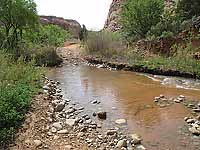
We are blessed, even in the drought years, to receive Mill Creek’s perennial flow. Without it something would be sorely missing. This tree-shaded lifeline of water irrigates our fields and gardens, recharges our aquifers, provides an important refuge for wildlife and birds, and offers a quick, uplifting tonic from the baking summer heat. During this transitional time of year it provides an ideal riparian retreat to explore during the interim while there’s still too much snow in the high country.
On this overly warm day in May my six-mile round trip hike starts at a former wagon route now known as the Steelbender - a rough 8-mile jeep trail that ends further up Mill Creek at Flat Pass. To get to this access point, drive approximately four miles south of town on Highway 191 and turn left at the Shell Station on to Spanish Trail Road. Then continue straight to the circle (the only one in our area) and take the turn for Westwater Drive to the graveled parking area that overlooks the Moab Golf Course.
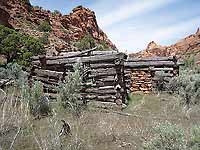 From this vantage point, I can see across the expanse of Spanish Valley to the distinctive jagged-edged rim of Behind the Rocks on the western horizon, while the rounded sandstone sentinels of Johnson’s Up On Top tower directly above the golf course. To get to the trailhead, I walk a short distance up the paved road to the gate and turn right at the Steelbender sign. On this route I quickly see a reminder of long ago: an old corral with a loading dock and watering trough. After that, the road makes a sweeping descent to a formerly irrigated field next to Mill Creek. Once I’m on the valley floor, I am grateful for the umbrella shade of cottonwoods as I continue upstream. Soon I’m finding some remnants of an old irrigation pipeline.
From this vantage point, I can see across the expanse of Spanish Valley to the distinctive jagged-edged rim of Behind the Rocks on the western horizon, while the rounded sandstone sentinels of Johnson’s Up On Top tower directly above the golf course. To get to the trailhead, I walk a short distance up the paved road to the gate and turn right at the Steelbender sign. On this route I quickly see a reminder of long ago: an old corral with a loading dock and watering trough. After that, the road makes a sweeping descent to a formerly irrigated field next to Mill Creek. Once I’m on the valley floor, I am grateful for the umbrella shade of cottonwoods as I continue upstream. Soon I’m finding some remnants of an old irrigation pipeline.
At the first creek crossing I realize there’s no getting around it – if I want to keep going, I have to get my feet wet! Reluctantly I take the plunge, but on this warm day splashing through the cool waters of this rushing stream feels surprisingly good.
In this majestic canyon the massive impenetrable walls of Navajo Sandstone contrast strongly against a deep blue sky. In the wetter areas Gambel’s oak, Russian olive, water birch, willow and cottonwood thrive. In the dryer soil I walk through perennial grasses, sagebrush, blackbrush, Mormon tea, junipers and squawbush. I also come across patches of prickly pear cactus sporting a full growth of their reddish fruit pods known as tunas. 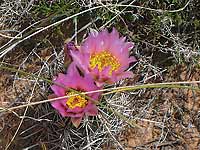
Within these canyon walls I welcome an embracing breeze as I celebrate this joyfulness-of-spring walk. April showers have brought the loveliness of May flowers – the unusual orange of the globemallow, pearly-white primroses, tiny white daisies, and big yellow daisies. I also admire the eye-catching red of the pentstemon, the fiery brilliance of Indian paintbrush, and the lovely lavender of the Whipple’s fishhook cactus. Once in awhile I’m also savoring the oh-so-sweet fragrance of cliffrose.
This hike is also for the birds; as the days get warmer and longer they can’t resist the urge to sing. The airwaves now hum with the melancholy vocalizations of the mourning dove’s coo – the whimsical tune of the Say’s phoebe – the “to-ka-ree” of the red-winged blackbird – the “kaBrik” voice of the ash-throated flycatcher, and the three note invitation to “drink your tea” by the spotted towhee. In fascination I watch the aerobatic ballet of the violet-green swallows, wishing I had some of their boundless energy.
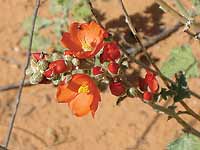 Just beyond the third stream crossing, the Steelbender trail climbs out of the canyon over some challenging rocky-ledged terrain. This is my signal to depart from the main track so I can further explore along the creek. At a section of downed fence a faint, unmarked path leads me through an abundance of Indian rice grass. Before long I’m opening and closing a cattle allotment gate to continue my walk through a long stretch of taller-than-me sagebrush with its aromatic smell of turpentine.
Just beyond the third stream crossing, the Steelbender trail climbs out of the canyon over some challenging rocky-ledged terrain. This is my signal to depart from the main track so I can further explore along the creek. At a section of downed fence a faint, unmarked path leads me through an abundance of Indian rice grass. Before long I’m opening and closing a cattle allotment gate to continue my walk through a long stretch of taller-than-me sagebrush with its aromatic smell of turpentine.
After three more crossings – there it is - just as I remembered it - a large abandoned log cabin. Sadly the years and weather have taken their toll. Although the walls and chimney are still upright, the roof is completely gone. The rock walls of the food storage cellar remain, but its roof has collapsed, too.
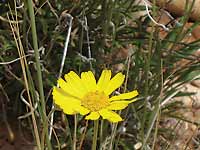 As always this nostalgic spot pulls me in. Studying the leftover fragments of times gone by, I wonder who built their home here and when did they leave? Pieces of the old corral indicate it must have been a ranch. Was this rancher a bachelor or did he have a wife and children? How often did they go into town? Did they ever feel lonely or were they content with their isolated way of life? And when they left, where did they go? As I examine the remains of this homestead I am overwhelmed with the feeling that they left a part of themselves behind.
As always this nostalgic spot pulls me in. Studying the leftover fragments of times gone by, I wonder who built their home here and when did they leave? Pieces of the old corral indicate it must have been a ranch. Was this rancher a bachelor or did he have a wife and children? How often did they go into town? Did they ever feel lonely or were they content with their isolated way of life? And when they left, where did they go? As I examine the remains of this homestead I am overwhelmed with the feeling that they left a part of themselves behind.
Plopping down underneath the rejuvenating shade of a juniper, I continue to ponder this perplexing mystery of who lived here and when. Finally after a long refreshing break, it is with great reluctance that I reload my pack. Then after a last lingering look at this haunting, filled-with-questions scene, I turn around and head back the way I came.

 From this vantage point, I can see across the expanse of Spanish Valley to the distinctive jagged-edged rim of Behind the Rocks on the western horizon, while the rounded sandstone sentinels of Johnson’s Up On Top tower directly above the golf course. To get to the trailhead, I walk a short distance up the paved road to the gate and turn right at the Steelbender sign. On this route I quickly see a reminder of long ago: an old corral with a loading dock and watering trough. After that, the road makes a sweeping descent to a formerly irrigated field next to Mill Creek. Once I’m on the valley floor, I am grateful for the umbrella shade of cottonwoods as I continue upstream. Soon I’m finding some remnants of an old irrigation pipeline.
From this vantage point, I can see across the expanse of Spanish Valley to the distinctive jagged-edged rim of Behind the Rocks on the western horizon, while the rounded sandstone sentinels of Johnson’s Up On Top tower directly above the golf course. To get to the trailhead, I walk a short distance up the paved road to the gate and turn right at the Steelbender sign. On this route I quickly see a reminder of long ago: an old corral with a loading dock and watering trough. After that, the road makes a sweeping descent to a formerly irrigated field next to Mill Creek. Once I’m on the valley floor, I am grateful for the umbrella shade of cottonwoods as I continue upstream. Soon I’m finding some remnants of an old irrigation pipeline. 
 Just beyond the third stream crossing, the Steelbender trail climbs out of the canyon over some challenging rocky-ledged terrain. This is my signal to depart from the main track so I can further explore along the creek. At a section of downed fence a faint, unmarked path leads me through an abundance of Indian rice grass. Before long I’m opening and closing a cattle allotment gate to continue my walk through a long stretch of taller-than-me sagebrush with its aromatic smell of turpentine.
Just beyond the third stream crossing, the Steelbender trail climbs out of the canyon over some challenging rocky-ledged terrain. This is my signal to depart from the main track so I can further explore along the creek. At a section of downed fence a faint, unmarked path leads me through an abundance of Indian rice grass. Before long I’m opening and closing a cattle allotment gate to continue my walk through a long stretch of taller-than-me sagebrush with its aromatic smell of turpentine. As always this nostalgic spot pulls me in. Studying the leftover fragments of times gone by, I wonder who built their home here and when did they leave? Pieces of the old corral indicate it must have been a ranch. Was this rancher a bachelor or did he have a wife and children? How often did they go into town? Did they ever feel lonely or were they content with their isolated way of life? And when they left, where did they go? As I examine the remains of this homestead I am overwhelmed with the feeling that they left a part of themselves behind.
As always this nostalgic spot pulls me in. Studying the leftover fragments of times gone by, I wonder who built their home here and when did they leave? Pieces of the old corral indicate it must have been a ranch. Was this rancher a bachelor or did he have a wife and children? How often did they go into town? Did they ever feel lonely or were they content with their isolated way of life? And when they left, where did they go? As I examine the remains of this homestead I am overwhelmed with the feeling that they left a part of themselves behind.